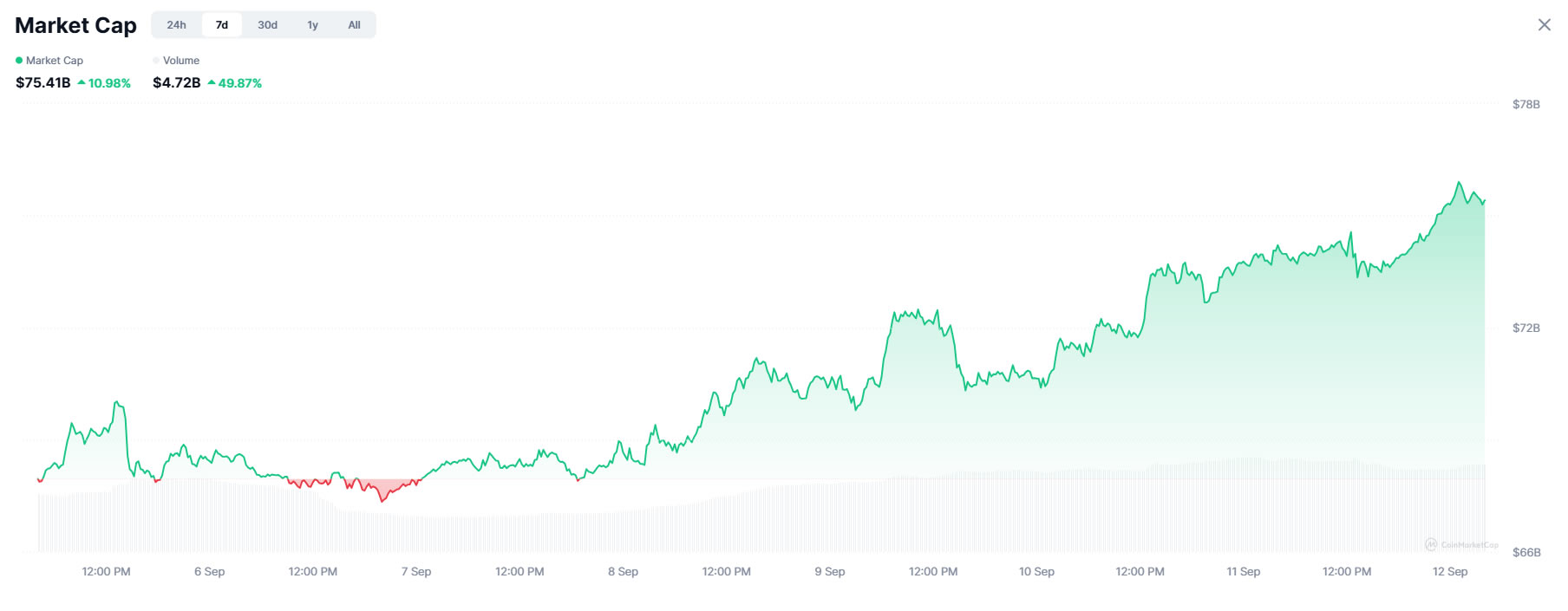Chainlink (LINK) May Benefit as Tokenized RWA Onchain Value Nears $29B and BlackRock Eyes Tokenized ETFs
LINK
LINK/USDT
$138,348,441.49
$13.37 / $13.08
Change: $0.2900 (2.22%)
+0.0065%
Longs pay
Contents
Tokenized real-world assets are digital representations of physical or financial assets on a blockchain, enabling faster settlement, programmable ownership, and broader access. The total onchain value of tokenized RWAs recently doubled year-to-date, driven by institutional flows and tokenization of private credit and treasuries.
-
RWA market cap hit a record high near $76B as RWA tokens rallied ~11% in seven days.
-
Onchain tokenized asset value topped $29B, with stablecoins bringing the broader total to $307B.
-
Over 75% of tokenized value is on Ethereum and layer-2 networks; private credit and US treasuries lead composition.
Tokenized real-world assets surge to record onchain values; discover implications for ETFs, stablecoins, and institutional flows — read the full analysis now.
The total onchain value of real-world assets has almost doubled since the start of the year as financial institutions flood into the space.
Cryptocurrencies supporting the real-world asset tokenization sector rose about 11% this week as the tokenized RWA market cap approached a new peak. Activity accelerated across oracle providers, high-throughput layer-1s, and institutional RWA DeFi platforms.
Over seven days the RWA token category moved from roughly $67 billion to just under $76 billion on Friday, according to CoinMarketCap (reported as a market reference in public data).

RWA token market cap hits a new peak. Source: CoinMarketCap
What are tokenized real-world assets?
Tokenized real-world assets are legally recognized assets represented by tokens on a blockchain, enabling fractional ownership, 24/7 transferability, and programmable settlement. Tokenization typically covers private credit, US treasuries, commodities, equities and funds, improving liquidity and accessibility for institutional and retail investors.
How did RWA onchain value reach a record high?
Onchain tokenized asset value topped $29 billion this week, per RWA.xyz data. Growth has been driven by institutional product launches, increased stablecoin liquidity, and expansion of tokenized private credit, which now represents more than half of onchain tokenized value.
When stablecoins are included, the broader onchain figure rises to about $307 billion. Market composition shows around 25% in tokenized US treasuries, with remaining value in commodities, alternative funds, equities and bonds.
How are specific crypto projects contributing to RWA growth?
Projects focused on tokenization and settlement infrastructure are benefiting strongly. Oracle providers (e.g., Chainlink), scalable layer-1s (e.g., Avalanche), and institutional RWA platforms (e.g., Ondo Finance) have seen price and activity tailwinds. These protocols supply price feeds, settlement rails, and custody integrations needed for compliant RWA tokenization.
Frequently Asked Questions
How big is the tokenized RWA market now?
The tokenized RWA market cap recently approached $76 billion after an 11% weekly gain. Onchain tokenized value alone topped $29 billion, per public RWA indexing sources. Including stablecoins, the broader onchain tally is about $307 billion.
Why are institutions pushing tokenization now?
Institutions cite faster settlement, fractionalization, cost efficiencies, and better market access as drivers. Public reports and industry commentary indicate regulatory modernization and fintech incentives are accelerating issuance.
Key Takeaways
- RWA market momentum: The RWA token category rallied ~11% this week, pushing market cap toward $76B.
- Onchain adoption: Tokenized assets onchain surpassed $29B, with private credit dominant and Ethereum/L2s hosting most value.
- Institutional interest: Asset managers and fintech firms are piloting tokenized funds and ETFs, signaling mainstream adoption.
Conclusion
Tokenized real-world assets are entering a new growth phase as institutional issuance and improved onchain infrastructure push values to record levels. Continued development in stablecoin liquidity, custody, and compliant tokenization will determine the speed of adoption. Follow COINOTAG coverage for ongoing updates and data-driven analysis.
Published: 2025-09-12 • Updated: 2025-09-12 • Author/Organization: COINOTAG
Comments
Yorumlar
Other Articles
Bitcoin Surges to $93,888: How Venezuela-US Tensions Triggered a Crypto Rally
January 5, 2026 at 07:04 AM UTC
Nokia Eyes AI Telecom Growth with Nvidia’s $1 Billion Partnership
January 1, 2026 at 12:45 PM UTC
CME Raises Silver Futures Margins Again After Extreme Price Swings
January 1, 2026 at 11:47 AM UTC

